
We spend our lifetimes living and learning, collecting little pearls of wisdom and knowledge that shape the way we think and act and perceive our world.
But sometimes, I think, we forget that the elders in our society have walked these same paths before. They’re like a great beautiful leather-bound book of knowledge just waiting to be cracked open and read. We just have to find the time to honour that wisdom, to seek them out and listen and learn from their stories.
A few months back I spent an afternoon with the grandmother of my friend Juan (y’know, the guy of homemade vegan Nutella fame.)
Grandmother Francisca is 81-years-old and grew up in Spain during the difficult years of civil war and rule under Spanish dictator Francisco Franco. It was a time of using and reusing by necessity because often there simply wasn’t enough to go around.
Francisca now lives in San Vicente, a little town just outside my adopted city of Alicante, along Spain’s southeastern Mediterranean coast. But she grew up in Castilla-La Mancha, that wide, sparsely-populated and windswept plateau dominating Spain’s interior. The region is famed for its proudly no-nonsense yet endlessly hospitable people, and for the bold wines and vast quantities of high-quality olive oil they produce.
Spaniards across this great nation use an astonishing amount of olive oil in their daily lives. They smother their breads and salads in the stuff. They fill heavy-bottomed pans half-full with thick, bubbling layers, then fry their famous tortillas or dunk all kinds of vegetables and meats in the piping hot liquid gold.
Often, they reuse this frying oil, allowing it to infuse with the flavour of meal’s past, until it takes on a deep golden colour, peppered with the crumbs of this and that.
Then, in the old way, this olive oil is recycled some more – into soap.
This is actually the traditional basis of Castile soap, that astoundingly all-purpose soap famed around the world as a natural and biodegradable base for everything from homemade hand washes and laundry detergents to green cleaning products.
It’s one of the oldest soaps known to mankind and is named after the region from which it originates: Francisca’s Castilla-La Mancha.
So naturally, I turned to her to learn the traditional recipe. We sat on her front porch for three hours one afternoon, chatting and laughing while gently stirring a giant red tub of soap by hand with a rough branch fossicked from the garden. (Okay, so Juan did most of the stirring. It’s actually pretty tough work.)

Here’s the recipe Francisca shared with us.
Ingredients
Makes about 60 bars.
5 litres water
5 litres olive oil
1kg lye (caustic soda)
For a smaller batch (makes about 25 bars):
400 millilitres water
2 litres olive oil
220g lye (caustic soda)
A note on why the ratio is different for the larger batch versus the smaller batch…
The 5l water to 5l olive oil is Francisca’s tried-and-true traditional recipe and it definitely works, as that’s exactly the measurements we used on the day. But that makes a huge amount of soap that can take some time to dry and cure, so I played around with the recipe when halving it and settled on the 400ml water to 2l olive oil ratio – it makes a slightly softer soap. But you can definitely add more water if you like, as the 1:1 ratio works, too.
Method
If you’re using recycled olive oil, first run it through a sieve to remove any remaining food crumbs.
In a well-ventilated area, add the lye to the water in a sturdy, heat-resistant plastic or stainless steel tub. Allow the mixture to cool for half an hour or so. Be very careful with this step! Never add water to the lye, as it can cause the lye to splatter, erupt, or explode out of the container. Lye in this form is also highly corrosive and can burn your skin, so protect yourself with gloves. Head here for more tips on working safely with lye.
Don’t worry about the caustic element to the lye. As this article explains, when fats like olive oil are combined with lye in proper proportions, a chemical reaction called saponification occurs. The end result is soap plus glycerin, which is all-natural and completely safe to use on your skin.
Pour the olive oil into the cooled lye mixture and begin stirring. Traditional wisdom says you mustn’t stop and should always stir in the same direction.
Continue stirring until the mixture thickens and forms a trace after the stirrer (as in the photo below – kind of like the consistency of honey). This can take a pretty long time by hand (think hours) so swap to a stick blender if you’re short on time. That should only take about 10 minutes, sometimes even less.
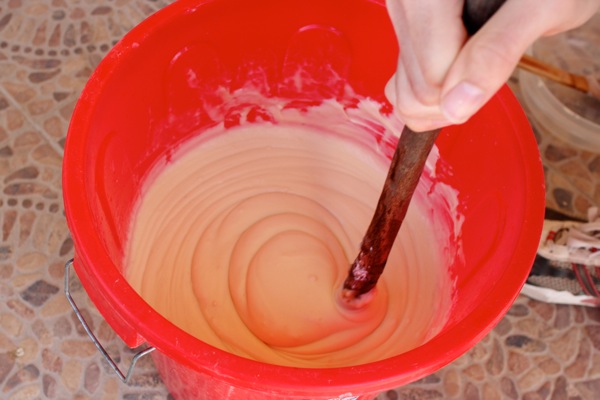
Pour the mixture into a large soap mould. We just used a cardboard box lined with old clothing rags. Plastic containers and metal cake tins also work great but you won’t be able to use them for food again in the future.

Stand the soap in a dry place until the block hardens. After a week or two (depending on the size of your block), it will be hard enough to chop into smaller blocks for further drying and curing. Be careful as the lye can still be caustic at this stage, so protect yourself with gloves.
You can see in the photo below that the blocks are still quite moist on the inside. They probably need another week or two of drying, until they turn a pale yellowy-white colour all over.

Once completely dry, go ahead and use your all-natural, homemade soap. These bars also form the base of my super-simple homemade laundry detergent.
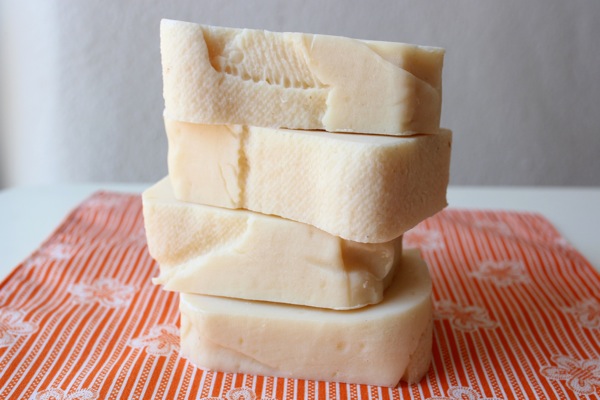
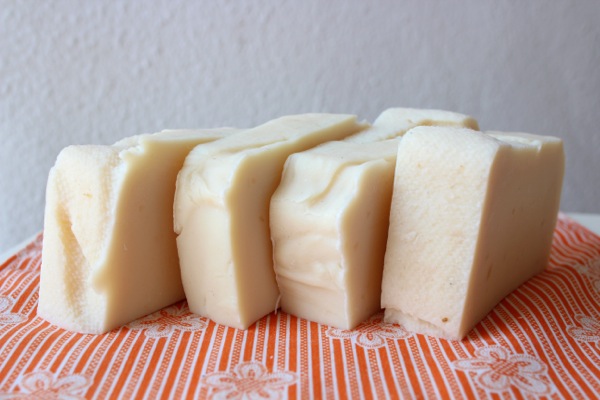
Cold process versus hot process soap making
There’s actually two ways to make your own soap from scratch. This recipe uses the cold process version, which means the bars of soap take about a month to six weeks to completely cure and dry.
There’s also a much-quicker hot version, with the soap bars ready to use in as little as a week. This article explains how to do both processes.
This Castile soap recipe is a great base from which you can play around with all kinds of natural colourings and fragrances. I’m currently having a bunch of fun experimenting with things like turmeric, beetroot, flowers and essential oils.

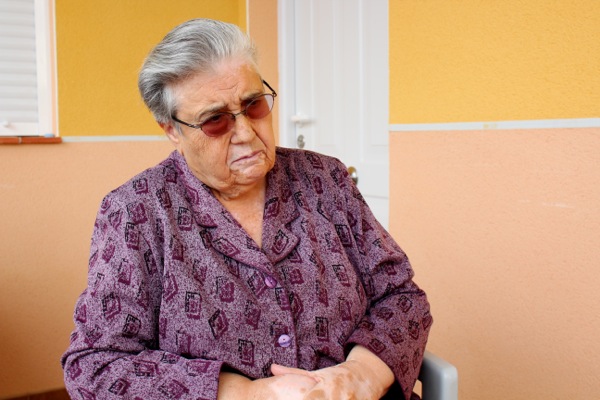

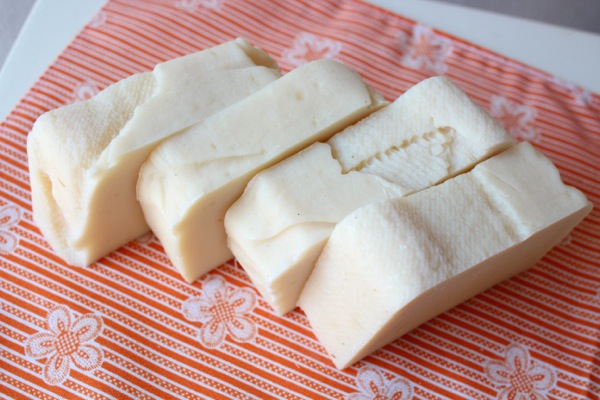
And to sign off, I have to say a huge thanks to Juan for sharing his grandmother with me, and an even bigger thanks to Francisca for sharing her wisdom with us all.
Share this with your mates
Tell me your thoughts…
31 Comments
Comments are closed.
![[Video] How to build a business that values people, planet and profit](https://korenhelbig.com/wp-content/uploads/2024/08/How-To-Build-A-Business-That-Values-People-Profit-The-Planet-an-interview-Koren-Helbig-and-Honey-Atkinson-1-500x383.png)
![[Podcast] Work/rest balance — a Reskilliance chat with Catie Payne](https://korenhelbig.com/wp-content/uploads/2024/08/Reskilliance-podcast-cover-500x383.jpg)
![[Video] Take a walk through my urban Adelaide permaculture garden](https://korenhelbig.com/wp-content/uploads/2024/06/Forward-Thinkers-video-500x383.png)


I am very much looking forward to trying this out on my holiday break :)
Oh, so cool! Let me know how you go, Kirsty. :)
Can you tell me where you buy caustic soda in Spain? Also I read you suppose to mix in stainless steal but here she is using a plastic tub, is it OK?
Hi there, you can actually buy it at the supermarket! Just ask for ‘sosa cáustica’. And yes, Francisca used a very thick plastic tub, but the caustic soda can burn through plastic so I’d recommend stainless steel just to be safe. :)
It’s good idea… All the best….
Stainless steel is fine, but be careful not to ever use aluminum!!
I make soap all the time, and I use plastic, both for mixing my lye water and making the soap batter. I mix my lye water in an ice bath to help it cool faster, and make my batter when both the oil and the lye water are between 85 and 95 degrees fahrenheit.
Please use a soap calculator (several can be found online) when adjusting recipes to different sizes.
This looks so interesting and do-able! I’ve wanted to try making soap from scratch for a long time… maybe this holiday break will be the time. Any thoughts as to whether this recipe could be made in a smaller batch?
Absolutely, Lori. It can be easily halved or even quartered, depending on how good your maths is! :)
[…] тут есть славный пост о традиционном кастильском мыле и бабушка Франциска делится своим […]
So much fun reading your article! The saponification is actually done within 24 hours, so unless the soap is lye heavy, it shouldn’t be caustic after this time. The additional curing time is for water to evaporate and the newly formed molecules to settle so that the bar becomes more dense, long lasting, and gentle. xo!
Oh cool, thanks for sharing your soap-making wisdom, Sarah!
Thanks for sharing this wonderful old day wisdom.
It’s my absolute pleasure! A wonderful excuse to spend an afternoon with Francisca. :)
5L water to 5L olive oil? That doesn’t sound right, especially if your smaller batch is only 400ml water to 2L olive oil.
Hey Sharon, the 5l water to 5l olive oil is Francisca’s tried-and-true traditional recipe and it definitely works, as that’s exactly the measurements we used on the day.
But that makes a huuuuuge amount of soap, so I played around with the recipe a little when trying to halve it and settled on the 400ml water to 2l olive oil ratio as it makes a slightly softer soap. But you can definitely add more water if you like, as the 1:1 ratio works, too.
Hope that clears up the mystery!
I’ve never made soap, but remember my grandma making it. So want to try this. Question do you add a little less oil if adding essential oil to the mix? And please thank her passing on a tried and true old time recipe. Trying to learn more before I start.
Hey Sandra, that’s awesome! And no, you shouldn’t have to adjust the amount of olive oil as the essential oils you’re adding are really quite minimal. I’ve even added as many as 50 drops of essential oil before, for a much stronger scent, and it hasn’t affected the overall oil ratio at all. Good luck!
I just finished making the soap. I’m assuming it doesn’t lather because there’s no solid oils. I made mine with lemon and corn meal. Can’t wait to try. Enjoyed the article,Thank you.
Hey Evonne, chuffed to hear you’ve given the recipe a go, and love your additions! You’re right in that this soap doesn’t lather all that much. I’m currently testing some additions for more of a lather, like salt, sugar and/or canola oil. Will let you know how I go! :)
Hi Koren. Can you get canola oil in Spain? I live in the Almería province and cannot find it here or in Granada province. Have also been to Murcia cannot find it in the small or big supermarkets. I’m a soaper and don’t like the feel of castile soap. So l use 25% coconut oil 75% Olive oil. This 25% makes it harder and gives it reasonable lather and cleansing properties. Olive oil is a great moisturizer but has no cleansing properties. I’d be interested to know where you can buy canola oil from.
Elsa, it’s so funny that you ask me this right now – I’ve just spent the past month searching for exactly the same thing! And I’m come to the conclusion that no, it’s not a thing here in Spain. Weird, right, considering how readily available it is elsewhere? I guess we could buy it online?
I’ve been experimenting with castor oil (which I bought online) for the same reason – wanting extra lather and cleansing properties – but the first two batches are still drying so I’m not sure how they’ll turn out. I used only 5% castor oil, 95% olive oil because that was the maximum recommended via the soap calculator (but also 15% castor oil and 85% olive oil in the second batch because I completely miscalculated the quantities! Ha.). Will keep you posted on how they go.
Do let me know if you ever track down the elusive Spanish canola oil!
Hiya! I’m wondering about the measures of the smaller batch. Should it not be an equal division between the total of the larger batch? Thanks
Be careful using castor oil in large quantities…it can make a soft soap which won’t harden. I ALWAYS run any recipe through a lye calculator (MistyMountianSage is a great one) and it will tell you the maximum lye and water to use for YOUR oils. BTW coconut oil is renowned for large fluffy lather, and also making a hard soap….
Hey Sharron, thanks for the advice. I did use a lye calculator for the castor oil experiment but yes, the soaps are quite soft. I’ll definitely have to give coconut oil a go! :)
[…] This is a great article on the history of castile soap that includes ingredients, a couple batch sizes and details on the hot and cold process. Click here […]
Am in love with this easy recipe and lam trying it today I hope the final resault be good .
Awesome! Let me know how you go. :)
Have you made liquid soap? I’d love a recipe for an all purpose cleaner. But it has to be pure Castile soap. One article I read said the temperature never gets above room temp. I’ve never heard of this.
THANK YOU for the lovely soap recipe will make this weekend. Francisca is real treasure.
Wahoo that’s great thanks for sharing this new methods I really appreciate because I know how to make liquid soap already .